Summer in Holland 2012


Our spring and summer cruise to Paris from Namur and back ended in early August. We had left our car there and, after three months, the battery was flat. I had anticipated such an event so had a pair of jump leads ready and our friendly capitaine Jean-Luc provided his car to start ours.
A quick trip back to Dinant to charge the battery and a big shop at Delhaize then the next day we drove up the De Gors marina at Arkel in Holland where we had booked Harmonie for two weeks later in the month. Back to Namur by train we set off the next day down the Meuse to Liege and then down the dreaded 14 metre deep Lanaye lock into Holland and the bunker barge at Maastricht. They are always pleased to see us here as we have spent a lot with them over the years. The white diesel tank topped up we continued down the Zuidwillelmsvaart and back into Belgium.
This canal was built by the Dutch when this part of Belgium was under Dutch rule as a short cut from Den Bosch to Maastricht and the Belgian coalfields. Subsequently the river Maas was improved for navigation as far as Maasbracht and the Juliana canal built to Maastricht so much bigger ships could navigate.
We were having problems connecting to the internet and when I tried to phone Proximus, our Belgian provider, I found my mobile was also disconnected so we were unable to contact them. The next day we stopped at Bree and found a Proximus agent who called them and we were told we were cut off as we hadn't paid a bill from last February. This was a hangover from the credit card fiasco during our New Zealand trip when the credit card was changed and Proximus could not debit our card. They were supposed to have issued a credit note and billed us again but that did not happen for obscure Belgian rules which Proximus blame on Visa as they are prohibited from debiting the same bill again. We were still supposed to have been able to call them and they could not explain that? So we had to pay in the amount owing into our Belgian ING bank account who sent it electronically to Proximus and the next day we were back on line. Had we not been in Belgium we would have had problems. Er, this is the 21st century?!

On down the Zuid Willelmsvaart and back into Holland, mooring on the canal bank in the middle of nowhere. The locks on this canal have all been rebuilt in the last few years. They are all controlled remotely by keepers sitting in front of TV monitors and are fast and efficient so the next day we cruised sedately down to Beek en Donk where we found a nice little mooring below the lock and before the lift up bridge so the big ships were not passing too fast. The little town has everything a hungry and thirsty bargee could require and we wandered around adding more food to our bulging fridge!
Next port was 's Hertogenbosch which is always abbreviated to Den Bosch. August is the height of the boating season and there are thousands more little boats in Holland that anywhere else in Europe so we were concerned to find a mooring in this popular city.
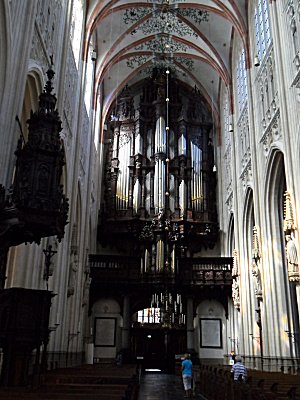
At lock zero there is about 200m of quay reserved for "sport" boats, which is what we are called in Holland, and thousands of metres of quay for commercials which is hardly ever used. It is time the authorities woke up to the tourist potential they are missing as boats have to move on for want of quay space. We were fortunate in securing a berth where we stayed for the allowed 3 days with Pat and Jill on Topaz breasting on to us for one night on their way south.
It was seven years since our last visit here and we were not able to visit the famous church of St John at that time due to renovation work. This is now largely complete so we were able to admire the great organ built in 1617 and now restored to it's original state. The church itself dates from the 13th century but the present Gothic church was constructed during the 14th and 16th centuries. The exterior is beautifully ornamented with spires and flying buttresses with statues of saints and angels.
Den Bosch is also famous for the Binnen-Dieze, a network of little canals that run largely underground and which you can explore in little tour boats but for us it is famous for spare ribs, the best in Holland. We found the little pub where we ate them seven years ago and they are still as good! Sue found an interesting shop where she bought an ornamental blue dish of Murano glass.

In perfect weather we sailed on down to the massive Engelen lock which we shared with 20 motor cruisers nervously fendering us off then out into the river Maas, turning back upstream at Heusden along the Andelse Maas and out into the mighty river Waal otherwise known as the Rhine. After 3km we turned north and through the Gorinchem lock (pronounced 'khor-a-kum') into the river Linge, mooring at De Gors Marina at Arkel. The main reason for mooring here was to fit a new navigation system called an Automatic Information System (AIS) of which more later. Fred Maartens of Ocean Sat, the firm who would install the system, arrived and checked what would be needed for the installation and told us his engineer would do the job the following week. We then headed south to good old Dunkirk and the ferry back to the UK.
We hit the A27 at speed and our exhaust fell off, possibly due to the gallons of Champagne we were transporting for the Harpers! Arriving at Les and Sally's we called Kwik-Fit (you can't get quicker?) who booked us in the following day for a new exhaust, four new tyres and an MOT. Salvo revived us with a roast pork dinner. There is nothing quite like a nice bit of crackling and Sal is an expert. £400 the poorer we motored towards Bristol after a couple of days leaving our new laptop battery there for collection of which more later. We arrived at Pete and Jans place in Bradley Stoke (north of Brissle) where we were given a tour and shown the house we are going to rent from Pete for the winter. They entertained us to dinner in their Yurt in the garden, equipped with electric roof heaters and very cosy as the weather had taken a rainy turn now the 'lympics were finished.
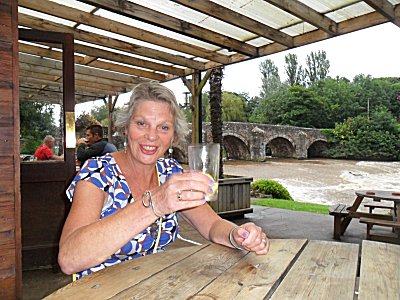
Talking about the 'lympics didn't we do well. I must admit that I was one of the doubters that expected the worst from both organisers and participants but it was an absolute triumph for both. Bit of a disaster for poor old Oz but I was unmerciless in my demands for ritual disembowelment when they only managed seven golds, why even the little old Kiwis managed six! Shame the Jaapies knocked our cricket team off the top spot but you can't have everything.
Our next stop was the Fishermans Cot at Bickleigh in Devon where Becky, my daughter and family met us for dinner. It is a thatched pub beside the river Exe, much swollen from the recent rains where Sue can be seen here enjoying a pre prandial gin and tonic and I enjoyed a really good pint or two of Brakspears bitter. We all went to Paignton Zoo the next day with the exception of eldest granddaughter Eliza who threw a wobbler for some reason and refused to come with us, something to do with her Mum deserting her at the tender age of 20! We all had a great day together without her but the next day we waved Becky, Tom and the two youngest goodbye at Exeter Station on their way to Darwin. Tears were shed. They are emigrating to Aussie as Becky was born there but left when she was three years old. We have relations in Darwin but hope that they don't settle there. Heat, humidity and crocodiles are not our bag!
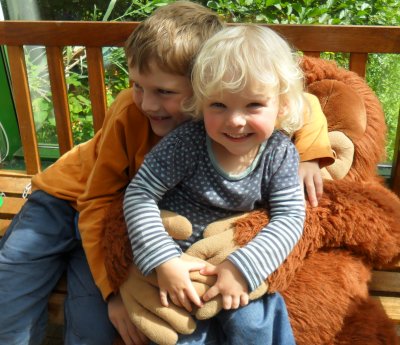
Here are the two youngest grandchildren Henry and Matilda Seren Rose being savaged by an Orang Utang which can be seen in the wild not that far from Darwin! Henry has lost his two front teeth but is getting new ones for Christmas!
After depositing eldest grandson Will back at his fathers house in Taunton, we continued back to Worthing and out for an Indian with Les and Sal. The replacement laptop battery still would not charge despite the Worthing repair shop insisting the first one was a dud. I now learn that although the charge light is on and the power meter says it is charging, there is circuitry within the laptop that controls the charging which might be faulty so I need to find a repair shop that knows what it is talking about!
Back in Holland we searched Gorinchem for a shop which sold plastic stick on lettering so we could stick on our EIN (European Identification Number) to the ship as required by law. After several tries we eventually found a hobby shop which charged me €46 for the privilege! The Ocean Sat engineer arrived to install the AIS. This involved a new antenna for the GPS signal, a new aerial for the VHF signal, wiring it all in to the new box of tricks which sits on the top of the instrument panel. In a few hours I was happily playing with my new toy, watching ships sailing down the river Waal at least 20km away and even further. This is a class A system which is used by even large ocean going vessels and transmits information giving a ships speed and position as well as data about its size and destination. It costs €2,500 but the Dutch government subsidises the cost so we only pay €400. A class B system can be used by vessels under 20 metres costing much less but it has a far less powerful VHF transmitter so you can not see so far and it transmits the data far less frequently.
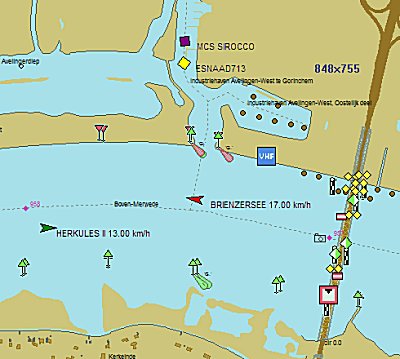
The AIS interfaces with a navigation program on a laptop so you can display the data graphically using electronic navigation charts (ENC). So it is much like the satnav in your car but one that would also display every other car around you in a 20km radius. Here is a screen dump of the river Waal about 6km from where we are moored. You can see the motorway bridge across the river and the red arrow is a tanker, the Brenzersee, travelling downstream at 17km/hr while coming upstream the green arrow is a cargo ship, the Herkules, travelling at a sedate 13km/hr. The actual position of the ship is where it's GPS antenna is located as if you are about to meet a 300m barge train and the antenna is on a pusher tug at the stern, you need to know that you are going to meet the bow of the first barge 300m earlier.
And here's another neat trick; if you go to http://www.vesselfinder.com/ and key in our MMSI number: 235068834 or "Harmonie II", you can see exactly where we are in real time.
Berthed alongside us at Arkel was 'Fryslan', a nice old barge with a nice lady owner, Essex girl Jeni Edwards. She was recovering from nasty accident when she fell down the open engine room hatch on board and did herself a lot of damage.

Jeni was a mine of local information. She winters at Geldermalsen on the river Linge and introduced us to more Essex folk, Roger and Julie, who keep their boat at Arkel and spend most of their summers there so they have almost become locals. We met them with Jeni in Gorinchem to watch the dragon boat races and locals kept stopping to say hello to one or other of them. Later we had a couple of beers in Rogers local watering hole, The Old Dutch pub where their dragon boat team had come third.
Thanks to Jeni we managed to organise a berth at Geldermalsen Marina which is 33km further upstream at the head of the Linge navigation in the province of Gelderland. It was a nice little town with just about every shop you could want within walking distance of the marina but nothing else of note. Only a few kilometres distant, however, is one of Hollands little treasures. Buren is famous for its links with the House of Orange and the whole of the towns buildings are listed.
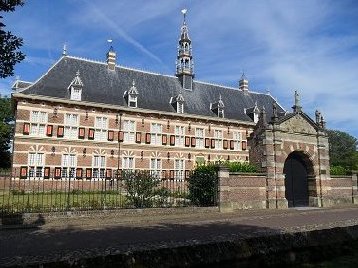

The Koniklijk Weeshuis (Royal Orphanage) was built by Maria van Nassau Geboren who was a princess of Orange in 1613 and must have been the most beautiful orphanage in the world! It is now a museum.
William of Orange, who married Mary, daughter of James II of England and became King William III of England, was the grandson of William, Prince of Orange who married Anne of Buren which was how Buren became famous. There is a nice bronze sculpture outside the church in Buren of grandparents William and Anne with their children Maria and Philips in 1557 who I suppose were one of William III's parents?

Our next sojourn was south to cross the busy river Waal. It is always fascinating to watch the stream of traffic on this mighty river and you are always seeing different type of ships. Most are familiar but the one above was a new one on us which was a huge car carrier. Count the number of cars she is carrying end to end and you get an idea of her size and note the 'lifty uppy' wheelhouse to get her under the bridges.
Zaltbommel, usually abbreviated to 'Bommel', is about a 12km cycle ride from Geldermalsen on the south bank of the Waal. It dates from about 850 AD and obtained its city rights in 1231. One of these rights was the freedom to organize a weekly market every Tuesday morning. We arrived on a Tuesday morning and sure enough found that the tradition was alive and well with a market in full swing. It is a quaint little fortified town, full of lovely old buildings and one of them in the market square was where Karl Marx was supposed to have written his "Das Kapital".


Many buildings around the town have what the locals call 'gootspoken', so called "gutter ghosts". These are little statues mounted on the top of the house gutters and downpipes and often depict the shop or trade that was carried on in that house. Here you can see one where the ghost is riding a bike and the house below used to be a bicycle shed.
The Saint Maarten church tower is 70 metres high but used to have a spire 30 metres higher, burnt down after a lightening strike in 1538. There is a bronze plaque at the entrance of the church about 2 metres above ground level which commemorates the height of the water in the flood of 1885. During the 1995 floods the ground level in the city was 3 metres below the level of the flood waters on the other side of the dyke between the city and the river.
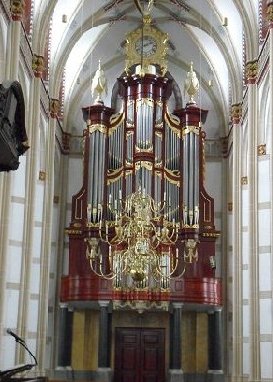
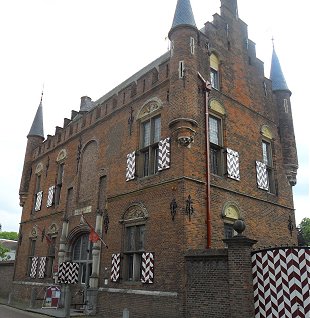
The Dutch seem to love their great organs and this one was rather splendid, embellished with sparkling brass work and surmounted by a clock. The Brasso stockist must be a rich man!
The other building of note in Bommel is the castle of Maarten van Rossum who was the Gelderland commander-in-chief and whose main claim to fame seems to have been his plundering of the Hague in 1528. It is now a museum.
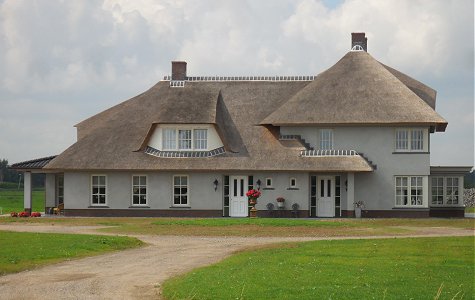
We found a Polish Delicatessen and could not resist buying some Sopocka and Kabanos, before sitting outside a cafe in the market square for our lunch of beer, wine and tapas and then cycling back through the Betuwe fruit fields, the trees laden with apples and pears, to Geldermalsen. Every other house seems to be thatched around here and what houses they are! Seems that fruit farming is a highly profitable business.
Back at Arkel we discovered that De Gors marina was to celebrate 30 years of business by holding a 'harbour day' on Saturday so we booked in until the Sunday. On Friday we drove down to Bruges and left the car at our winter mooring yacht club car park. Graham and Bardy had arrived in Effort and entertained us to a Champagne lunch before we caught the train back to Arkel.
The dawn bought hot sunny weather for De Gors harbour day and the Brit contingent were content to sit on the clubhouse terrace, drink beer and watch the antics of the youngsters swimming, racing dinghies with outboards and cavorting inside inflated floating plastic balloons although I was tempted to have a go on the bouncy castle! Pancakes with bacon or fried whiting were provided in ample proportions but eventually the beer and wine took effect and we sidled off to bed as the live group started.

The next day we headed North up the Merwede canal to Vianen for a night then continued as far as the pleasant village of Jutphaas. The September weather had now improved to something like normal for late summer and we decided to cycle in to Utrecht for lunch, a distance of about 8km. We missed our turning after we had crossed the Amsterdam - Rhine canal and ended up in the outskirts but soon found a route into the centre and chained our bikes to the railings alongside the Oudegracht. We were last here a couple of years ago and loved the atmosphere of this leafy canal, winding it's way through the heart of the city with restaurants of every description on the quays either side. We chose an Italian called Il Pozzo this time and my Pizza was belissimo but Sue gave her salad and wine the thumbs down. The Italian lemoncello yoghurt ice cream at the nearby stall did get the thumbs up though.
We could not visit any of the museums, it being a Monday when they are all closed, however, a pleasant afternoon was spent wandering around the old centre of the city, nosing around in the little shops and noting the abundance of different eating houses for a future visit.
We cycled back down the Lange Niewstraat, past the Pallaeskameren, a group of almshouses built in 1651. The lucky residents were given free accommodation and a certain amount of food and drink. Just around the corner are the palatial mansions of the rich in the Nieuwgracht who built the almshouses, perhaps to salve their consciences? We took a few wrong turns on the way back but eventually managed to follow the prescribed cycle route. You follow a series of numbered points but occasionally you miss a turn or do not see the sign and end up going in the wrong direction, there being as many cycle tracks as there are roads in Holland if not more!
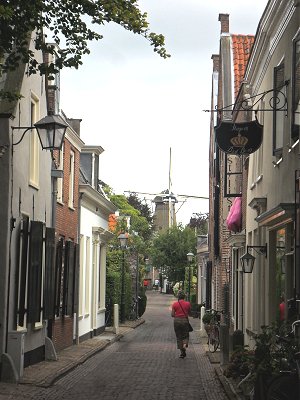
It was another glorious morning as we dropped down the big lock into the Amsterdam - Rhine canal with a big 2000 tonner who went through astern then had to turn to go up towards Amsterdam. While waiting for him to turn, an impatient Dutch cruiser skipper waiting to go into the lock gave me the proverbial 'get out of my way' gesticulation and disappeared into the lock before I could formulate a suitable response! We have met this 'canal rage' syndrome on some occasions and experienced it yet again on the Vecht, passing through a narrow section with barely enough room to pass, a Dutch cruiser came boring towards us in an effort to catch the open bridge. How he managed to avoid us remains a mystery.
The Vecht is possibly the prettiest river in Holland, enriched by a succession of grand houses built by wealthy Amsterdammers in the 17th and 18th centuries along the river banks between Maarssen, where we spend a night, and Loenen, where we spent another.
We had planned to visit Hilversum but on reading the Dutch waterways guide it said the canal was only open to vessels up to 12 metre in length and 3.75 metres beam, despite the ANWB charts and the PC - Navigo program saying otherwise, we therefore decided to head for Amsterdam.

We phoned the Amstelsluis to see if we could moor there which is right in the centre of the city and very inexpensive but they advised that there was no space so we moored at Diemen in the outskirts on a free mooring, rare in these parts! The tram runs alongside the canal so you are in the centre within half an hour. We know Amsterdam well having visited many times over the years and it remains one of our favourite cities. The sun continued to shine as we wandered around the little streets and canals, soaking up the atmosphere with an Amstel beer or two beside the Amstel river and finishing up at a Malaysian restaurant for dinner before catching the tram back to Diemen.
We cruised sedately down the Amstel the next day as far as Uithoorn then into new territory down the Kromme Mijdrecht. The name means winding in Dutch and it certainly lived up to it's name, especially at the entrance to the lock at Woerdense Verlaat where there was just enough room for Harmonie to make a right angle turn into the lock.
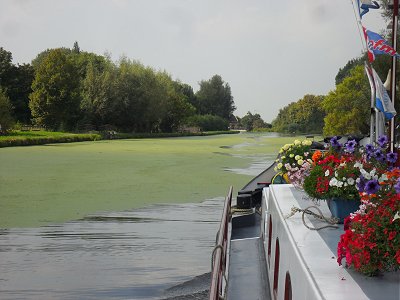
The lock is 5.1m wide and 30m long so assume it must be possible for a longer ship to navigate. The lock only adjusts the water level a few inches and you are then on the even narrower river Grecht which limits draught to 1.5 metres. It being a gloriously hot sunny Saturday, every man and his dog was out on the river and we had a few near misses. The Dutch tend to drive their boats like they ride their bikes as if they are the only ones on the river and seemingly impervious to those around them! They compose text messages on their phones while riding their bikes through streets crowded with pedestrians, occasionally looking up to avoid a collision!
Joining the Oude Rijn at Woerden we encountered a sea of duckweed despite the busy river traffic. We managed to find another nice free mooring in the middle of Bodegraven where we stayed for a couple of nights, sitting in the shade on our foredeck, watching the continual procession of sloops racing past, some of them dangerously overloaded with half naked, possibly pleasantly inebriated Dutch persons.

The weather cooled as we sailed down to Alphen and turned south onto the river Gouwe which took us to Gouda. It is some years since we were here and then only for a few hours so we decided to stop for a few days, especially as they only charge us €18 for three days including electricity. Gouda is more than cheese although we did buy a tasty wedge aged for 18 months. You can get it aged up to 5 years! The magnificent late Gothic town hall dating from 1450 stands aloof in the centre of the market square where you can be married and there were some silly people doing just that when we arrived although, apart from the bride, the wedding party did not seem very well dressed for the occasion!?
St. Janskerk in Gouda was originally Catholic when this part of the Netherlands was under Spanish rule and many benefactors donated stained glass windows who are depicted on the windows themselves, amongst them Margaretha of Parma. In most paintings of the time and therefore the stained glass, portraits tend to depict certain similarities, as if the artist had a fixed image of a human face in each of his characters.
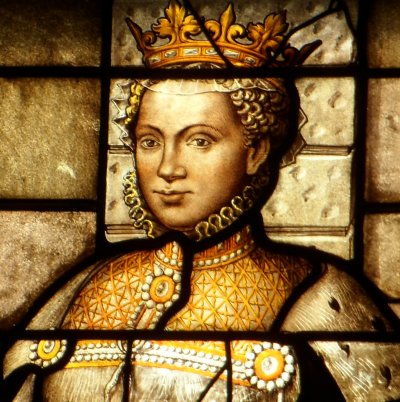
The picture of Margaretha is the exception to the rule as she has a unique and exceptionally beautiful face, unless the artist wanted to flatter her, as you can see from the photograph of a section of the window which she sponsored. During the reformation such windows were more usually destroyed by the so called Iconoclasts, but the windows here were so beautiful that they were not destroyed and eventually even Protestant benefactors added to them. The windows reflect the politics of the time which culminated in the 30 Years War between Spain and the Netherlands during which time Gouda became economically and politically isolated. The city recovered during the 17th and 18th centuries due to it's trade in cheese, candles and clay pipes. When the pipe trade declined they turned their skills to pottery and produced ceramics in Art Nouveau and Art Deco designs of which there is a large collection in the local museum. In 1840, Gouda Baker Gerard Kamphuisen invented the Syrup Waffle (Siroopwafel in Dutch), still in production today and much prized by the Dutch as it is very cheap!
We discovered a very good Tapas bar in Zuegstraat called La Cubanita where we could eat as many plates as we liked on weekdays for €17.50 each! It's a Dutch franchise and they have restaurants in several towns and cities throughout Holland. The web site is in Dutch but click on Vestigingen to get the locations of them all. On a Monday night when most restaurants in Gouda were empty or closed, this one was full and we had to sit at the bar to eat.
We were woken one morning by Ben, one of the lock keepers. Thieves had completely removed one of our large wheelhouse double glazed windows in the middle of the night while we slept, reached inside and stolen our laptop computer and pocket camera. I did hear a noise in the night and went up into the wheelhouse after seeing a figure outside from one of our bedroom portholes but could see no trace of anyone after several minutes and went back to bed. Ben called a local glazier for us who screwed a sheet of hardboard across the window frame. He also called the police and three of them turned up quite quickly. They told us that they do have a problem at the moment and the local villains are very professional. They also suspect that it is drugs or alcoholic related. I then called our Dutch insurers who asked for a copy of the police report and photographs of the window so I recommissioned an old camera to do this.

Later the glazier told us that it would take several weeks to obtain replacement glass so we arranged with him to repair it in October when we get to our new winter moorings in Belgium. While he was measuring up I asked him if he could replace all the other double glazed windows along each side of the forward superstructure that had lost their vacuum and we agreed a price for this work.
Having just spent money upgrading the stolen computer I was not 'appy that I now had to get the new navigation software and all my lost programs working on a new machine, however, every cloud has a silver lining, or so I thought, and at least I would have a more modern computer running the Windows 7 operating system which I purchased from a local store together with a new pocket camera. Navigation software was soon up and running and after a couple of days work, most programs had been retrieved, either from the external hard disk, which the thieves had thoughtfully left dangling by it's USB cable outside the window frame, or downloaded from the internet with a few exceptions.
The Vodafone data card was redundant as these slots are no longer fitted to laptop computers so I had to purchase a USB dongle to reconnect to the internet. On our return to Belgium I can use the Proximus sim card in the dongle to reconnect to the Belgian system. The other problem was that the stand alone TV tuner would only work on Windoze XP which you can not buy any more and no drivers were available for Windoze 7. I found a replacement tuner on the web but it was not available locally so we are deprived of radio and TV in the wheelhouse for the time being.
Due to temporary blockages on the Hollansche Ijssel North and South and the Gouda locks being closed on Sunday we could not leave Gouda until Monday 17th so we abandoned plans to revisit Arkel and planned a more direct route back to Belgium to arrive on Sue's birthday. Peter Harris managed to get us a permanent mooring in Eeklo so we cancelled with Flandria at Bruges. Eeklo is midway between Gent and Zeebrugge and close to the Dutch border, a small town of about 20,000 and a quiet secure mooring at the local yacht club. It means that we do not have to start cruising on 1st April to avoid the high summer mooring rates and can wait for the fine weather later in the year at no extra cost. We also have a permanent mooring available throughout the year should we need it.
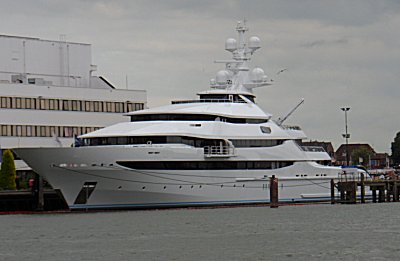
Our next port of call was Dordrecht and we fought tide and current all the way there. The engineer who installed our AIS system told us he was installing four marine satellite TV systems in a yacht built for a rich Arab which we passed on the way and you can see the four domes on the masthead. He told us that the Arab liked the work they did so much, that he bought the shipyard and built this yacht on spec but if he doesn't sell it he will keep it for himself. In the master bedroom wall there is a giant aquarium across the whole width of the ship and four TV systems are required for the huge number of TV's he has around the ship. We passed the ship on our way to Dordrecht and I think a figure of sixty million Euros was the asking price!
At Dordrecht we moored in the Wolwevershaven (literally wool weavers harbour) with all the historic ships. We had to provide the harbour master with the ships papers showing she was built in 1925 before he would let us in. The harbour is not very sheltered from the wash of passing ships of which there are many, particularly the fast catarmarans which they use for water buses. We clocked one on the way on the AIS doing 46km/hr and boy do we roll when they go past the harbour entrance. The other problem is the there is a 2m tide difference so we have to keep the ropes slack to avoid getting hung up on the wall at low tide. The advantage is it's free mooring!
Here, and throughout southern Holland, there is a new system of electricity provision. First you must have a key, which is provided FOC, to open the sparkling new cabinets situated at intervals along the quay. Next you plug your cable in and note the number of the socket you have used, then you call a number where you can pay by credit card and the power is switched on, all done by computer. You must first register at www.walstroom.nl where you need to enter your name and address, the EIN of the ship and the PIN you want to use as a password. The web site is in four languages and the locations of all the electricity points are listed. Once you have registered you can plug in anywhere you see the electricity plug logo sign by just dialling a number but you should remember to dial it again when you leave to tell the computer to switch off the power.
Dordrecht is the oldest town in Holland and received its city charter in 1220. It was the most important port in the region until the 1500's when Rotterdam took over.
We had not had any Asian food, apart from a mediocre Malasian in Amsterdam, since May, when we had a dire Chinese meal in Rethel on our way to Paris with Pete and Jan for which Jan has still not forgiven me! I researched Asian restaurants in Gouda on the web and found none within reasonable walking distance that looked any good and did the same for Dordrecht without success. Walking around the old city we finally found a down market Chinese which we rejected but, low and behold, just around the corner in Vriesestraat was what looked like an up market Indonesian which has no presence on the web so that is about to change. If you are in Dordrecht and, like me, are desperate for some Asian cuisine then look for Mulia at Vriesestraat 11 where the two of us ate a tasty, spicy Bami Goreng and Satay in very pleasant surroundings with a good bottle of Claret for the princely sum of €45. A further search revealed a Thai restaurant but there does seem to be an absence of Chinese in this part of Holland
Along the Nieuw Haven we found a WW2 museum of the 1940 - 45 resistance in and around Dordrecht. The museum houses a huge collection of uniforms, guns, photographs and other memorabilia from the period from all the participants and the man in charge was a mine of information. Dordrecht was of strategic importance both to the Germans during the invasion in 1940 and the allies during the liberation in 1944 due to its proximity to the bridges across the great rivers.
Next door is the mansion of Simon van Gijn who was a lawyer, businessman and collector. He wrote; "The past is a reflection of the present, and he who wants to thoroughly understand his own era, the present, must not be a complete stranger to the past, the source of the present." He died in 1922 leaving his house and collection of prints and other artifacts to the Old Dordrecht Society with a request that his home should be made into a museum and be open to the public. It has been such since 1925 and has been largely preserved with most of its contents as it was when he died with later additions by others, notably the only gilt leather room in Holland found in 1992 and transferred to the museum in 2001. Well worth a visit if you are interested in late 19th and early 20th century furnishings, the house itself dating from 1729. There is also a fine collection of Dutch silver, Chinese and Japanese porcelain with a toy collection in the attic!

Our last visit in Dordrecht was to the Grote Kerk which dates from 1285 and is a walk through history, particularly in the churches stained glass windows which depict Dordrecht history. Great flood, Fire and Battle of the 14th and 15th centuries, liberation from Spain, William of Orange and the Assembly of Free States in the 16th and 17th centuries. I was particularly taken with the latest windows installed in 2007 which represent the Guilds of Dordrecht. The other item which can not fail to impress is the sold gold communion service displayed in a Safe which was donated in 1744 by one Philippe Diodati who was a native of Dordrecht and a director of the East India Company in Batavia. He must have had a bob or two as they still had money left over to put in the beautiful brass baroque style Choir Screen!

The church tower, which can be climbed for a great view over the city, looks rather strange with a square clock tower on the top. It was originally designed to have a spire there but due to subsidence, now sorted, that idea was abandoned and it is definitely on the lean! No surprise that it contains the heaviest carillon in Europe at 52 tonnes, the heaviest bell weighing in at 10 tonnes!
Three days of rockin' and rollin' was enough so we set off for Willemstad. This time we had tide and current with us so bounded along at up to 14km/hr at 1500rpm and arrived at noon. We then decided to continue on to Tholen, through the separate yacht lock into the Volkarak. It is perhaps of interest to explain the tidal influences on the waterways in the area of Southern Holland. From Rotterdam south, all the waterways are fresh water until you get to the Oosterschelde. This is because of the various coastal defences that were put in place following the disastrous floods of 1953 which drowned over 1800 people.
Huge dams, sluices and storm surge barriers were built during the late 50's, 60's and 70's in a massive civil engineering undertaking using huge suction dredgers to remove the silt from the sea bottom to construct the dykes. I was working for Lister Blackstone at the time and one of our unique engine ranges consisted basically of two vertical in-line engines bolted together and known as twin banks. Each bank of cylinders were connected together by an integral gear train to a single output shaft and you could specify the gear ratio and therefore the output speed. This meant we could offer the Dutch engineers a high power medium speed engine with a built in gearbox having a higher output speed suitable for the big dredge pumps they were using. For some years the Dutch bought almost our entire production of these engines.
The dam and sluices across the Haringsvliet controls the output of the entire Rhine delta. It holds back the fresh water flowing down the Rhine and Maas during high tides and releases the water during low tides. This diverts the fresh water flow of these rivers when the sluices are closed and has the effect of making all the rivers up to Rotterdams outlet to the sea, fresh water instead of salt but they are still affected by the tides and so rise and fall depending on their distance from Rotterdam. So from Gouda when we first cleared the lock into the tidal Hollansche Ijssel we had the flood tide against us, then turning upstream on the Lek (really the Rhine) we were against the current and turning south onto the Noord we again had the current against us flowing from the Merwede (really the Rhine and the Maas) until Dordrecht.

Heading south from here we had the benefit of the same current as far as its confluence with the Dordse Kil where we were fortunate to catch a flood tide down to the Hollandse Diep, where there is little tidal influence as its level is controlled by the Haringsvliet sluices. The Volkerak is kept fresh as is the Schelde Rijnverbinding until you get to Antwerp or in our case the Oosterschelde lock. Through that and we are in sea water all the way to Terneuzen where we go through the sea lock into the Terneuzen - Gent canal.
This route is the main north south route for all inland commercial shipping and they are literally lined up like trucks on the inside lane of a British motorway! Imagine if all this cargo was transported by trucks, how much busier the Dutch and Belgian roads would become. Biggest ship we saw weighed in at over 5,000 tonnes and the fastest, apart from the fast catarmarans around Dordrecht, was on the Volkerak where a police launch passed us doing 37km/hr!
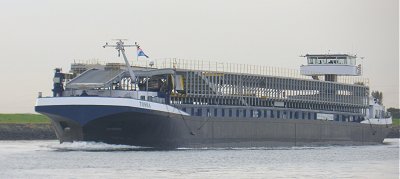
With a good weather forecast and favourable tidal predictions we set off through the tidal Oosterschelde at 8am into a stiff breeze. Arriving at the Zuid Beveland canal, now against the tide, we passed, close up, the car carrier I had photographed a few weeks ago on the Waal. Here we were amongst the big ships again and squeezed into the Hansweert lock with four of them and three Dutch yachts. It had taken about two and a half hours to here and low tide at Terneuzen was not until 1pm so we were well ahead of schedule as we sailed out into the mighty Westerschelde on the ebb tide doing over 17km/hr at 1500rpm engine speed leaving the yachts in our wake.
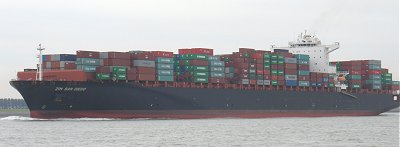
We passed three big container ships travelling upstream against the tide but still doing 25km/hr and creating a swell of metre high waves. I was quite impressed with Harmonies sea keeping in these conditions. She rolls like a bastard beam on but if you can keep her head into the swell she feels really comfortable apart from some slamming in the short waves. We arrived at Terneuzen at 11.30am, radioed the Control station our position relative to a bouy and were given instructions to proceed to the East sea lock where we squeezed in between the big fellas that had left us for dead at Hansweert.
Having the electronic charts on PC-Navigo connected to GPS signals from the AIS and being able to see all the shipping in these crowded waters gave me a lot of confidence, although the conventional paper chart was still at the ready in case of failure. Knowing exactly where you are relative to other ships, bouys and charted water depth is a massive help in a busy seaway and I think that the investment in the system has been well worthwhile.
Once through the lock we found a mooring in the cut behind the lock complex and waited for Peter and Jan to arrive. We were then conveyed to the very good restaurant on the dyke above the Westerschelde where we all enjoyed an excellent seafood lunch and watched the ships doing what we had just done.
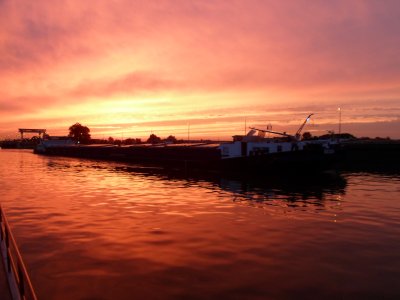
It was a long lunch and back on board Harmonie we looked at the distance we had yet to travel to Eeklo and decided to sail on to Evergem lock so we could arrive at Eeklo at a reasonable time the next day. It was 7.30pm when we arrived and were treated to a magnificent sunset. Off early again the next morning we arrived at Eeklo at 12 noon to be met by Peter who introduced us to the Harbour Master, Gerard, who turned out to already know us from our time in Kerkhoven where he used to moor his boat. Then we met Robert, the yacht club president, who showed us all the work they were doing to accommodate us for the winter involving clearing and seeding the canal bank and installing electricity. Peter then gave us a Cooks tour of Eeklo before whisking us off back to Bruges where we visited the Proximus shop and the nice lady gave me a new sim card to replace the Dutch one so we can access the internet in Belgium.
It was Sues birthday the next day so we celebrated it with Pete and Jan at a pub around the corner from the coupure in Bruges. The food was good but the service abysmal and it took two and a half hours to get to our main course. Reminded me of the critique in a recent Telegraph newspaper of Greg Wallace's restaurant where the critics tried to ring the restaurant from their table to ask how long their food was going to be but their call was not answered!
The next day the weather turned foul with heavy rain and high winds. Our satellite dish was blown overboard and several of our flower boxes turned over with the wind. Our car, Desmond, was bogged down in the loose earth in the newly made parking spot and we dug him out with a garden trowel and the help of a passing cyclist. Sues iron caught fire and burnt a hole in the ironing board cover which makes more than three troubles at one time when they are only supposed to come in threes! Good thing was we arrived from Holland before the bad weather and as we have now left Holland a new page is called for.





